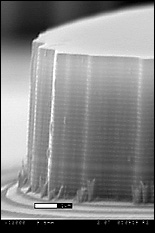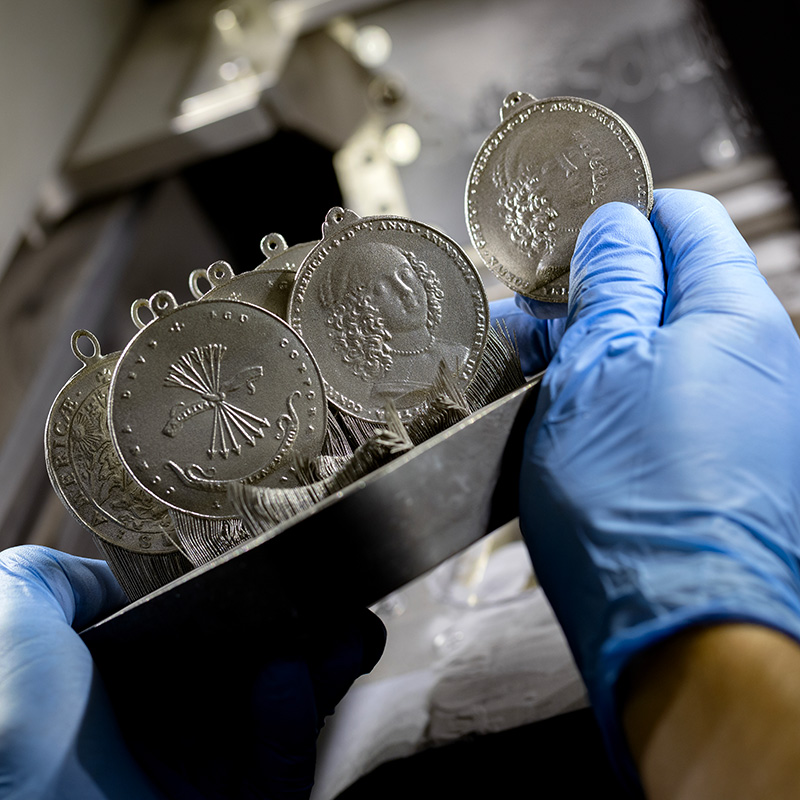News Story
Christou Designs Better Lasers for Threat Detection

Christou’s laser mesas are constructed out of bands of different materials, each with a different function. At the base is a multilayered mirror that reflects all of the laser’s electromagnetic radiation up and out. The laser itself is generated in the lower band, whose material is designed to have energy levels high enough to allow lasing—the stimulated emission of radiation, in this case infra-red—to take place. The upper layers of the mesa have been designed to allow all of the infrared light generated to be transmitted out, without filtering or diminishing. At the top of each mesa is an aperture approximately 10 microns wide, and above that, a "blocking layer" that can be used like a shutter. The laser mesa's overall shape was chosen to create a cylindrical distribution of light.
The lasers Christou works with are built at the nano- and micron scales, and are similar to those used in fiberoptic networks and small electronics. The light they emit is in the infrared range, invisible to the human eye.
Christou uses a technique called molecular beam epitaxy to "grow" his lasers from the bottom up by depositing one molecular layer of material at a time. Ultimately, thousands of tiny lasers, called “mesas” because of their shape, rise up from the surface of an indium-gallium-arsenide wafer to a height of one micron—thinner than a sheet of paper.
Lasers tuned to wavelengths 3-20 microns long can be used to detect chemical and biological agents. The laser is emitted from a handheld device into the atmosphere. If it hits the targeted molecules, the molecules emit their own radiation that is reflected back in a distinct way. This reflected radiation is sensed by another component of the device, which alerts the user to the presence of the agent.
Current detection technology, however, is inefficient: the lasers used don't cover all of the wavelengths occupied by biological threats, and they are tuned to only one frequency, meaning they can only test for a specific agent. If you want to test for another substance, you must use a different laser.
Christou's new lasers overcome two major stumbling blocks: they make headway into the critical 3-20 micron range, spanning 3-6 microns, and are individually tunable, meaning their wavelengths can be adjusted. This could greatly improve the flexibility and effectiveness of the devices people use to scan for hazardous materials. "When you have an unknown biological or chemical agent that may be dangerous," he explains, "you don't know the wavelength of the electromagnetic radiation it's emitting. Being able to tune the laser means you can scan a number of wavelengths and when you see a reaction at a particular one, you could identify what’s been found. It's like using the tuner on a radio to scan for stations because you don't know exactly where they are."
Innovative design, the right combination of materials, and improved fabrication techniques led to the breakthrough. "We had to develop the theory for the [laser mesas'] multiple layers and the calculation which allowed us to grow them," says Christou. "If you're off by a hundredth of a nanometer or don't have the right surface treatments on the materials, it could block the lasing of infrared radiation from coming out, reflect it back, or distort it on that wavelength, and it would not be able to detect and stimulate emissions from biological sources. The laser has to be a pure beam in order to be effective."
Christou and his colleagues presented their work in late 2007 at the SPIE Europe Remote Sensing Conference in Florence, Italy. Christou was also invited to present his work as a late paper at the Photonics West conference. The project was funded by the NASA Space LIDAR Technology Center under the UMD-NASA Cooperative agreement.
Learn more:
For a more technical overview of Christou's research, please see the Department of Materials Science and Engineering's Research Spotlight, "Laser Design: A New Approach Using the Phenomena of Quantum Cascading for Chemical Sensors in the 3-6 μm Spectral Region."
Visit Professor Christou's web site »
Published April 16, 2008









